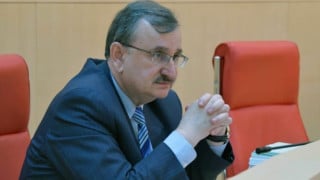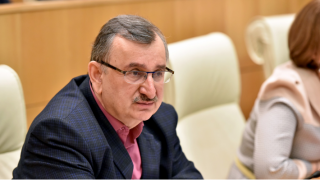In the discussion of the dynamics of pensions, it is important to analyse the real figures; that is, the inflation-adjusted figures. As compared to 2012, the real pension increased by 58.5% or 1.6 times. In his interview with FactCheck, Roman Gotsiridze clarified that he was referring to several aspects in his statement; in particular, the decrease of pensions as a result of the GEL depreciation against USD and inflation. The MP also added that whilst discussing pensions, attention has to be paid to three main groups: healthcare, food and utilities.
Firstly, of mention is that an analysis of the dynamics of pensions in USD-denominated figures is irrelevant. Incomes and expenses of pensioners are denominated in GEL and the after effects of currency depreciation are reflected in GEL-denominated prices; that is, inflation and, therefore, we have to analyse the real figure vis-à-vis the dynamics of pensions.[1] In the case of food and non-alcoholic beverages, the real pension increased by 44.2%, in the case of utilities the increase is 76.6% and in the case of healthcare the growth is 53.5%. Therefore, there has not been a real decrease in pensions as compared to 2012 for those groups which Mr Gotsiridze believes to be especially relevant for pensioners.
Analysis
Member of the United National Movement, Roman Gotsiridze, on air on TV Kavkasia, stated (from 40:00): “Pensions in fact dropped nearly to the 2012 figure.”
In the discussion of the dynamics of pensions, it is important to analyse the real figures; that is, the inflation-adjusted figures. In time, as a result of inflation, less products and services can be purchased for GEL 1. Therefore, it is possible that the nominal pension remains unchanged but the real pension decreases. As shown in Table 1, in spite of the current crisis the real pension in 2020 increased by 58.5%; that is, 1.6 times as compared to 2012. In 2013-2014 as well as in 2016-2018, the real pension decreased because the nominal pension figure did not increase.
Table 1: Nominal and Real (2012 Prices) Pension Dynamics in 2012-2020
|
|
2012 |
2013 |
2014 |
2015 |
2016 |
2017 |
2018 |
2019 |
2020 |
|
Nominal |
100 |
150 |
150 |
160 |
180 |
180 |
180 |
200 |
220 |
|
Real |
100.0 |
146.5 |
143.7 |
146.2 |
161.5 |
151.3 |
149.1 |
154.8 |
158.5 |
Source: National Statistics Office of Georgia
Of note is that the general inflation rate includes the price level dynamics for 12 main groups of goods. These groups are as follows: 1) food and non-alcoholic beverages, 2) alcoholic beverages and tobacco, 3) garments and footwear, 4) accommodation, water, energy, gas, heating, 5) furniture, household items, house cleaning-maintenance, 6) healthcare, 7) transport, 8) communication, 9) vacation, leisure and culture, 10) education, 11) hotels, cafes and restaurants and 12) different goods and services. Given the aforementioned, we could argue that analysing the pension dynamics based on general inflation figures would give us a picture not corresponding to the reality because it is unlikely that a pensioner, the bulk of whose income is his pension, spends money, for instance, on alcoholic beverages and tobacco as well as on education, hotels, cafes, restaurants, etc. As clarified by Roman Gotsiridze in his interview with FactCheck, he was referring to several aspects in his statement; in particular, the decrease of pensions as a result of both the GEL depreciation against USD and inflation. The MP also added that whilst discussing pensions, attention has to paid on three main groups: healthcare, food and utilities.
Firstly, of mention is that the analysis of the dynamics of pensions in USD-denominated figures is irrelevant. Incomes and expenses of pensioners are denominated in GEL and the after effects of currency depreciation are reflected in GEL-denominated prices; that is, inflation and, therefore, we have to analyse the real figure vis-à-vis the dynamics of pensions. Table 2 shows the dynamics of pensions according to the groups of food and alcoholic beverages, healthcare and utilities.
In the case of food and non-alcoholic beverages, real pension increased by 44.2%, in the case of utilities the increase is 76.6% and in the case of healthcare the growth is 53.5%. Therefore, there has not been a real decrease in pensions as compared to 2012 for those groups which Mr Gotsiridze believes to be especially relevant for pensioners.
Table 2: Inflation and Respective Real Pension Dynamics in 2012-2020 vis-à-vis Food and Non-alcoholic Beverages, Utilities and Healthcare Groups
|
Year |
2012 |
2013 |
2014 |
2015 |
2016 |
2017 |
2018 |
2019 |
2020 |
|
|
Nominal Pension |
100 |
150 |
150 |
160 |
180 |
180 |
180 |
200 |
220 |
|
|
Food and Non-Alcoholic Beverages |
Annual Inflation |
-3.6 |
5.7 |
2.5 |
3.8 |
1.6 |
7.3 |
1.7 |
12.3 |
8.9 |
|
Real Pension (2012=100) |
100.0 |
141.9 |
138.4 |
142.2 |
157.5 |
146.7 |
144.3 |
142.7 |
144.2 |
|
|
Accommodation, water, energy, gas and heating |
Annual Inflation |
-2.5 |
3.9 |
1.0 |
8.3 |
0.1 |
2.0 |
3.1 |
3.7 |
0.4 |
|
Real Pension (2012=100) |
100.0 |
144.4 |
143.0 |
140.8 |
158.2 |
155.1 |
150.4 |
161.2 |
176.6 |
|
|
Healthcare |
Annual Inflation |
2.8 |
1.5 |
6.7 |
10.5 |
2.1 |
8.1 |
2.9 |
3.5 |
1.8 |
|
Real Pension (2012=100) |
100.0 |
147.7 |
138.5 |
133.6 |
147.3 |
136.2 |
132.4 |
142.1 |
153.5 |
|
Source: National Statistics Office of Georgia
--------------------------------------
[1] Taking the price level into account.








